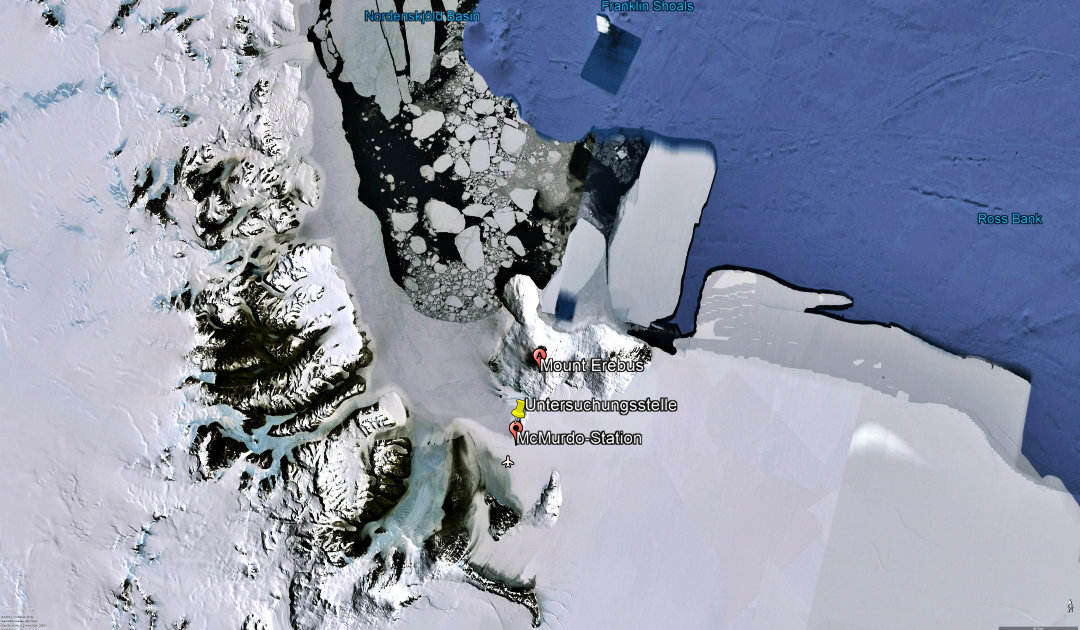
The seabed around Antarctica is only partially explored. Most of the most examined places are located within the vicinity of research stations and offer scientists a small insight into the oceanic diversity under the ice. But what was discovered almost directly at the doorstep of the largest Antarctic station, McMurdo, is a big surprise: a place where methane seeps directly from the seabed. The potent greenhouse gas forms the basis of a large-scale bacterial world.
The bacterial mats around the source were first visited in 2012 by assistant professor Andrew Thurber of Oregon State University and a first sample was taken. Before that, no such mat had been described at this point before. Thurber also discovered the reason for this relatively quickly: an opening in the seabed from which methane seeped. By the time Thurber came back to the same spot in 2016, more mats had already formed at a second, higher location. “The microbial mat is the road sign that there’s a methane seep here,” explains Thurber. “We don’t know what caused these seeps to turn on. We needed some dumb luck to find an active one, and we got it.”

The investigations of Thurber and his team are remarkable in another point. For the first time, the development of bacterial communities around such sources can be investigated. This is particularly important because the microbial community filters the leaking methane and uses it to generate energy. If this filter is missing, the methane finds its way to the surface and into the atmosphere. And methane is about 25 times more potent as a greenhouse gas than carbon dioxide is. Although methane appears to be widespread under the seabed, active seeps are little known. In the Southern Ocean, only one site was known, which had already dried up when it had been discovered.
“What was really interesting and exciting was that the microbial community did not develop as we would have predicted based on other methane seeps we have studied around the globe,” Thurber continues. “The microbes we found were the ones we least expected to see at this location.” The category of bacteria most frequently observed at methane seeps around the world was found here only after five years, but despite the coldness of the water. But the bacterial community was not yet as developed that the leaking methane would be filtered. The amount of escaping methane that is likely to enter the atmosphere was still high. From these results, the team concludes that the microbes found are either new types of methane-processing bacteria or that there is a succession in which more and more methane-feeding bacteria following up on each other. “Because of this discovery we can now uncover whether seeps just function differently in Antarctica or whether it may take years for the microbial communities to become adapted,” concludes Thurber.

Methane is a natural and global resource. At the same time, the gaseous substance is also a potent greenhouse gas. The total amount of methane under the seabed is estimated at 1,800 gigatonnes, not counting the Southern Ocean. Because here only rough estimates are known. Thurber and his colleagues estimate that between 80 and 400 gigatonnes of methane are once again under the ice shelves and the coasts of Antarctica. Researchers believe that globally, substantial parts of the continental slopes consist of methane ice. But where the origin of this newly discovered seep lies just a few meters below the surface of the water is not known. But if it shows that amounts of methane lie beneath the ice shelf and ice-covered coasts of Antarctica, these, as well as the speed at which the bacterial communities form to intercept methane before reaching the atmosphere, would also have to be incorporated into the climate models, Thurber concludes. But how long the latter lasts remains a mystery to Antarctica until further notice. Thurber and his colleagues estimate that between 80 and 400 gigatonnes of methane are once again under the ice shelves and the coasts of Antarctica.

Dr Michael Wenger, PolarJournal
Link to the study: Thurber et al (2020) Proc R Soc B 287 (20201134) Antarctic endemism and microbial succession impact methane cycling in Southern Ocean
More on the subject:





